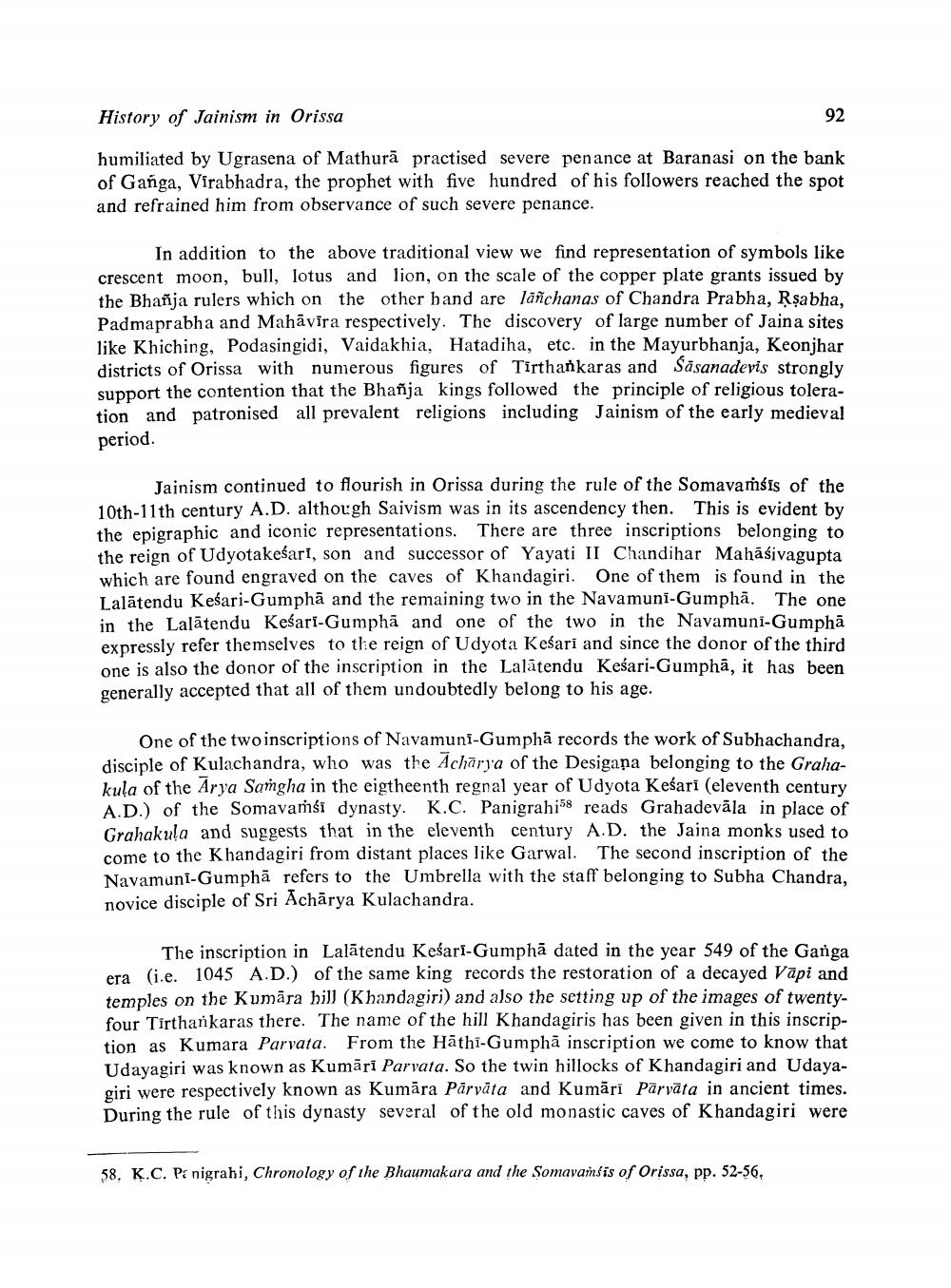________________
History of Jainism in Orissa
92
humiliated by Ugrasena of Mathurā practised severe penance at Baranasi on the bank of Ganga, Virabhadra, the prophet with five hundred of his followers reached the spot and refrained him from observance of such severe penance.
In addition to the above traditional view we find representation of symbols like crescent moon, bull, lotus and lion, on the scale of the copper plate grants issued by the Bhanja rulers which on the other hand are lāñchanas of Chandra Prabha, Rşabha, Padmaprabha and Mahāvira respectively. The discovery of large number of Jain a sites like Khiching, Podasingidi, Vaidakhia, Hatadiha, etc. in the Mayurbhanja, Keonjhar districts of Orissa with numerous figures of Tirthańkaras and Säsanadevis strongly support the contention that the Bhanja kings followed the principle of religious toleration and patronised all prevalent religions including Jainism of the early medieval period.
e figures of Wed the principle the early me
Jainism continued to flourish in Orissa during the rule of the Somavaṁsis of the 10th-11th century A.D. although Saivism was in its ascendency then. This is evident by the epigraphic and iconic representations. There are three inscriptions belonging to the reign of Udyotakeśari, son and successor of Yayati II Chandihar Mahāśivagupta which are found engraved on the caves of Khandagiri. One of them is found in the Lalātendu Keśari-Gumph, and the remaining two in the Nava muni-Gumphā. The one in the Lalātendu Keśari-Gumphā and one of the two in the Navamuni-Gumphā expressly refer themselves to the reign of Udyota Kesari and since the donor of the third one is also the donor of the inscription in the Lalātendu Keśari-Gumphā, it has been generally accepted that all of them undoubtedly belong to his age.
One of the twoinscriptions of Navamuni-Gumphā records the work of Subhachandra, disciple of Kulachandra, who was the Acharya of the Desigapa belonging to the Grahakula of the Arya Samgha in the eigtheenth regnal year of Udyota Keśari (eleventh century A.D.) of the Somavaṁsi dynasty. K.C. Panigrahi58 reads Grahadevāla in place of Grahakula and suggests that in the eleventh century AD. the Jaina monks used to come to the Khandagiri from distant places like Garwal. The second inscription of the Navamuni-Gumphā refers to the Umbrella with the staff belonging to Subha Chandra, novice disciple of Sri Achārya Kulachandra.
The inscription in Lalātendu Keśari-Gumphā dated in the year 549 of the Ganga era (i.e. 1045 A.D.) of the same king records the restoration of a decayed Vapi and temples on the Kumāra hill (Khandagiri) and also the setting up of the images of twentyfour Tirthankaras there. The name of the hill Khandagiris has been given in this inscription as Kumara Parvata. From the Hathi-Gumphā inscription we come to know that Udayagiri was known as Kumāri Parvata. So the twin hillocks of Khandagiri and Udayagiri were respectively known as Kumāra Pārvāta and Kumāri Parvata in ancient times. During the rule of this dynasty several of the old monastic caves of Khandagiri were
58. K.C. Pa nigrahi, Chronology of the Bhaumakara and the Somavaṁsis of Orissa, pp. 52-56,




